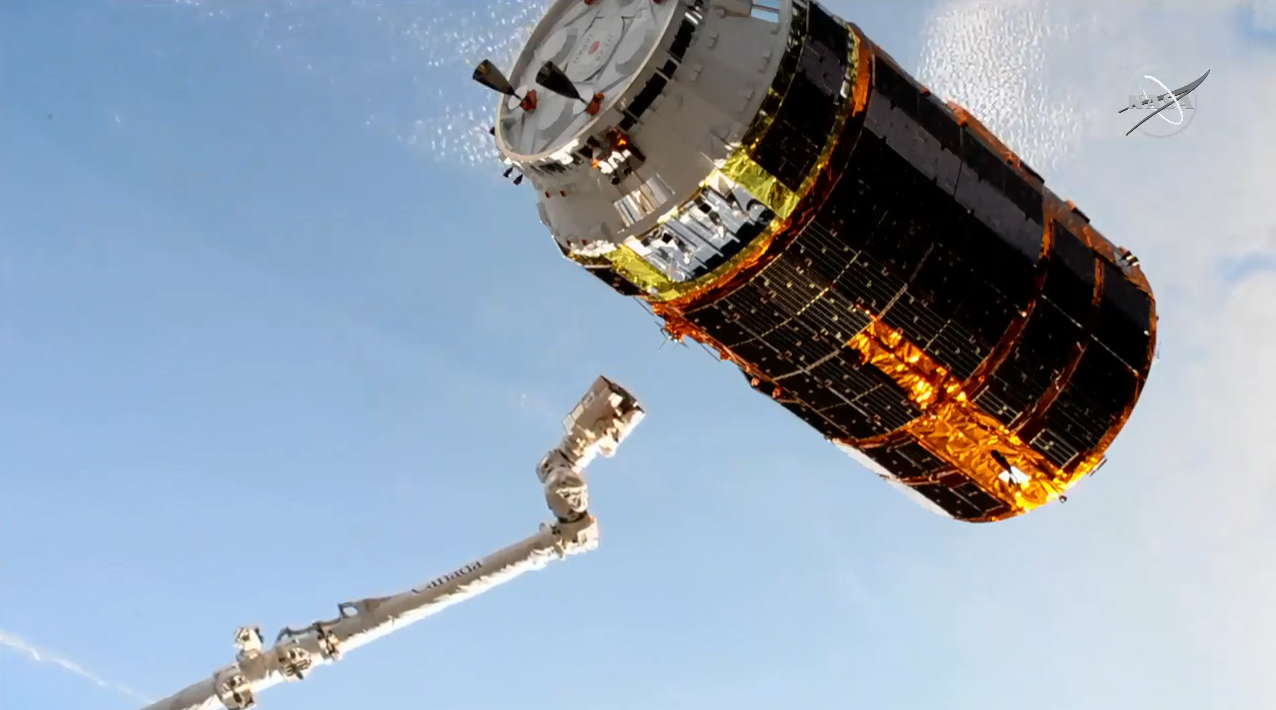Japanese Cargo Ship Leaves Space Station Ahead of US Supply Ship Launch
HTV-8 meets its fiery doom this weekend!
An unpiloted Japanese cargo ship left the International Space Station Friday (Nov. 1), wrapping up a month-long delivery mission as a new U.S. supply ship prepares for a weekend launch.
Astronauts on the space station used a robotic arm to release the cargo ship, called HTV-8, from the station at 1:21 p.m. EDT (1713 GMT) as the two spacecraft sailed 261 miles (420 kilometers) above the Pacific Ocean, just west of the California coast.
"Gone but not forgotten," station astronaut Christina Koch of NASA, who controlled the arm during HTV-8's release, wrote on Twitter later. "Watching the HTV cargo ship depart @Space_Station today and remembering the complex dance of the robotic arm that marked the beginning of its stay."
Video: Watch HTV-8 Leave the Space Station!
Photos: Japan's Robotic Space Cargo Ship Fleet

HTV-8's departure sets the stage for the launch of a U.S. cargo ship, the Cygnus NG-12 spacecraft built by Northrop Grumman, from NASA's Wallops Flight Facility on Wallops Island, Virginia. That mission is scheduled to launch Saturday (Nov. 2) at 9:59 a.m. EDT (1359 GMT) and arrive at the station two days later to deliver another 4 tons of supplies.
The Japan Aerospace Exploration Agency (JAXA) launched HTV-8 to the space station Sept. 24 using an H-IIB rocket that lifted off from the Tanegashima Space Center in southern Japan. The spacecraft arrived at the station four days later, delivering more than 4 tons of supplies - including vital new batteries for the outpost's solar arrays.
Video: How Japan's HTV Cargo Ships Work
Related: Japan's HTV Space Truck Explained (Infographic)
Get the Space.com Newsletter
Breaking space news, the latest updates on rocket launches, skywatching events and more!
Gone but not forgotten! Watching the HTV cargo ship depart @Space_Station today and remembering the complex dance of the robotic arm that marked the beginning of its stay. The batteries being removed were later installed by us on spacewalks—can’t beat that for teamwork! pic.twitter.com/UsJHFAWJTENovember 1, 2019
HTV-8 spent 34 days attached to an Earth-facing port on the station's U.S. Harmony module. On Saturday night (Nov. 2), the spacecraft will fire its thrusters to intentionally fall out of orbit. It is42042 expected to burn up over the Pacific Ocean.
JAXA's HTV spacecraft (the name is short for H-II Transfer Vehicles) are also known as Kounotory (Japanese for "white stork"). They are part of an international fleet of robotic cargo ships that includes Russia's Progress vehicles, SpaceX's Dragon, Northrop Grumman's Cygnus spacecraft and the European Space Agency's Autonomous Transfer Vehicles.
- Space Station's Robotic Cargo Ship Fleet (A Photo Guide)
- Photos: Japan Launches HTV-4 Cargo Ship to Space Station
- JAXA: Japan's Aerospace Exploration Agency
Email Tariq Malik at tmalik@space.com or follow him @tariqjmalik. Follow us @Spacedotcom and Facebook.

Join our Space Forums to keep talking space on the latest missions, night sky and more! And if you have a news tip, correction or comment, let us know at: community@space.com.

Tariq is the Editor-in-Chief of Space.com and joined the team in 2001, first as an intern and staff writer, and later as an editor. He covers human spaceflight, exploration and space science, as well as skywatching and entertainment. He became Space.com's Managing Editor in 2009 and Editor-in-Chief in 2019. Before joining Space.com, Tariq was a staff reporter for The Los Angeles Times covering education and city beats in La Habra, Fullerton and Huntington Beach. In October 2022, Tariq received the Harry Kolcum Award for excellence in space reporting from the National Space Club Florida Committee. He is also an Eagle Scout (yes, he has the Space Exploration merit badge) and went to Space Camp four times as a kid and a fifth time as an adult. He has journalism degrees from the University of Southern California and New York University. You can find Tariq at Space.com and as the co-host to the This Week In Space podcast with space historian Rod Pyle on the TWiT network. To see his latest project, you can follow Tariq on Twitter @tariqjmalik.
